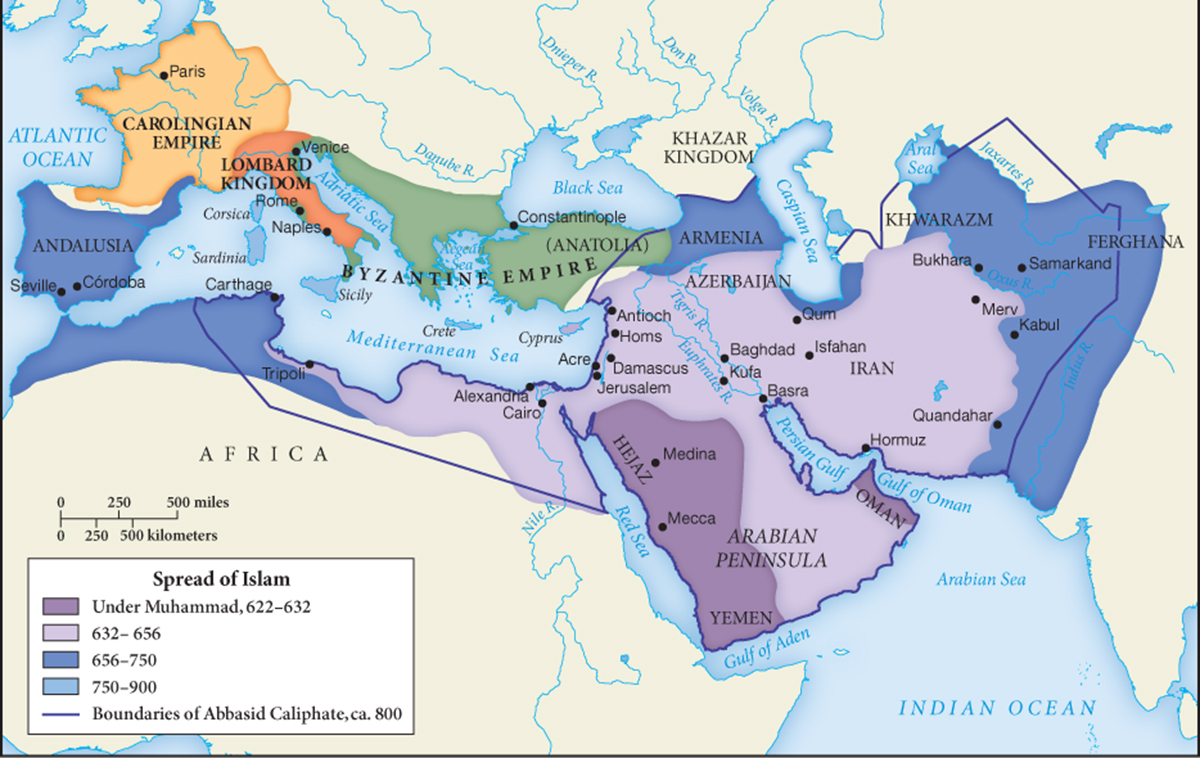War, Conquest, and Tolerance
Within a few years of Muhammad’s death in 632, Arab armies engaged the Byzantine and Persian Sassanid empires, the great powers of the region. It was the beginning of a process that rapidly gave rise to an Arab empire that stretched from Spain to India, penetrating both Europe and China and governing most of the lands between them (see Map 9.2). In creating that empire, Arabs were continuing a long pattern of tribal raids into surrounding civilizations, but now these Arabs were newly organized in a state of their own with a central command able to mobilize the military potential of the entire population. The Byzantine and Persian empires had for a century or more suffered periodic epidemics of the plague that decimated their urban populations, while the more remote and scattered Arabs of the Arabian Desert were more protected from this pestilence. Furthermore, these great empires, weakened by decades of war with each other and by internal revolts, continued to view the Arabs as a mere nuisance rather than a serious threat. But by 644, the Sassanid Empire had been defeated by Arab forces, while Byzantium, the remaining eastern regions of the old Roman Empire, soon lost the southern half of its territories. Beyond these victories, Muslim forces, operating on both land and sea, swept westward across North Africa, conquered Spain in the early 700s, and attacked southern France. To the east, Arab armies reached the Indus River and seized some of the major oases towns of Central Asia. In 751, they inflicted a crushing defeat on Chinese forces in the Battle of Talas River, which had lasting consequences for the cultural evolution of Asia, for it checked the further expansion of China to the west and made possible the conversion to Islam of Central Asia’s Turkic-

Change
Why were Arabs able to construct such a huge empire so quickly?
The motives driving the creation of the Arab Empire were broadly similar to those of other empires. The merchant leaders of the new Islamic community wanted to capture profitable trade routes and wealthy agricultural regions. Individual Arabs found in military expansion a route to wealth and social promotion. The need to harness the immense energies of the Arabian transformation was also important. The fragile unity of the umma threatened to come apart after Muhammad’s death, and external expansion provided a common task for the community.
While many among the new conquerors viewed the mission of empire in terms of jihad, bringing righteous government to the peoples they conquered, this did not mean imposing a new religion. In fact, for the better part of a century after Muhammad’s death, his followers usually referred to themselves as “believers,” a term that appears in the Quran far more often than “Muslims” and one that included pious Jews and Christians as well as newly monotheistic Arabs. Such a posture eased the acceptance of the new political order, for many people recently incorporated in the emerging Arab Empire were already monotheists and familiar with the core ideas and practices of the Believers’ Movement—
In other ways too, the Arab rulers of an expanding empire sought to limit the disruptive impact of conquest. To prevent indiscriminate destruction and exploitation of conquered peoples, occupying Arab armies were restricted to garrison towns, segregated from the native population. Local elites and bureaucratic structures were incorporated into the new Arab Empire. Nonetheless, the empire worked many changes on its subjects, the most enduring of which was the mass conversion of Middle Eastern peoples to what became by the eighth century the new and separate religion of Islam.